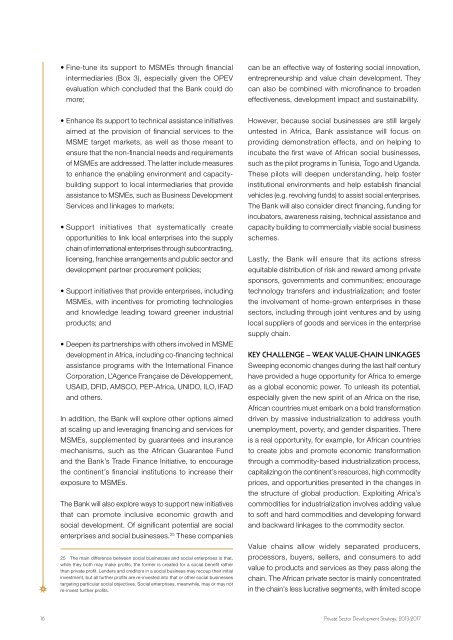2013-2017_-_Private_Sector_Development_Strategy
2013-2017_-_Private_Sector_Development_Strategy
2013-2017_-_Private_Sector_Development_Strategy
Create successful ePaper yourself
Turn your PDF publications into a flip-book with our unique Google optimized e-Paper software.
• Fine-tune its support to MSMEs through financial<br />
intermediaries (Box 3), especially given the OPEV<br />
evaluation which concluded that the Bank could do<br />
more;<br />
can be an effective way of fostering social innovation,<br />
entrepreneurship and value chain development. They<br />
can also be combined with microfinance to broaden<br />
effectiveness, development impact and sustainability.<br />
• Enhance its support to technical assistance initiatives<br />
aimed at the provision of financial services to the<br />
MSME target markets, as well as those meant to<br />
ensure that the non-financial needs and requirements<br />
of MSMEs are addressed. The latter include measures<br />
to enhance the enabling environment and capacitybuilding<br />
support to local intermediaries that provide<br />
assistance to MSMEs, such as Business <strong>Development</strong><br />
Services and linkages to markets;<br />
• Support initiatives that systematically create<br />
opportunities to link local enterprises into the supply<br />
chain of international enterprises through subcontracting,<br />
licensing, franchise arrangements and public sector and<br />
development partner procurement policies;<br />
• Support initiatives that provide enterprises, including<br />
MSMEs, with incentives for promoting technologies<br />
and knowledge leading toward greener industrial<br />
products; and<br />
• Deepen its partnerships with others involved in MSME<br />
development in Africa, including co-financing technical<br />
assistance programs with the International Finance<br />
Corporation, L’Agence Française de Développement,<br />
USAID, DFID, AMSCO, PEP-Africa, UNIDO, ILO, IFAD<br />
and others.<br />
In addition, the Bank will explore other options aimed<br />
at scaling up and leveraging financing and services for<br />
MSMEs, supplemented by guarantees and insurance<br />
mechanisms, such as the African Guarantee Fund<br />
and the Bank’s Trade Finance Initiative, to encourage<br />
the continent’s financial institutions to increase their<br />
exposure to MSMEs.<br />
The Bank will also explore ways to support new initiatives<br />
that can promote inclusive economic growth and<br />
social development. Of significant potential are social<br />
enterprises and social businesses. 25 These companies<br />
25 The main difference between social businesses and social enterprises is that,<br />
while they both may make profits, the former is created for a social benefit rather<br />
than private profit. Lenders and creditors in a social business may recoup their initial<br />
investment, but all further profits are re-invested into that or other social businesses<br />
targeting particular social objectives. Social enterprises, meanwhile, may or may not<br />
re-invest further profits.<br />
However, because social businesses are still largely<br />
untested in Africa, Bank assistance will focus on<br />
providing demonstration effects, and on helping to<br />
incubate the first wave of African social businesses,<br />
such as the pilot programs in Tunisia, Togo and Uganda.<br />
These pilots will deepen understanding, help foster<br />
institutional environments and help establish financial<br />
vehicles (e.g. revolving funds) to assist social enterprises.<br />
The Bank will also consider direct financing, funding for<br />
incubators, awareness raising, technical assistance and<br />
capacity building to commercially viable social business<br />
schemes.<br />
Lastly, the Bank will ensure that its actions stress<br />
equitable distribution of risk and reward among private<br />
sponsors, governments and communities; encourage<br />
technology transfers and industrialization; and foster<br />
the involvement of home-grown enterprises in these<br />
sectors, including through joint ventures and by using<br />
local suppliers of goods and services in the enterprise<br />
supply chain.<br />
Key Challenge – Weak Value-Chain Linkages<br />
Sweeping economic changes during the last half century<br />
have provided a huge opportunity for Africa to emerge<br />
as a global economic power. To unleash its potential,<br />
especially given the new spirit of an Africa on the rise,<br />
African countries must embark on a bold transformation<br />
driven by massive industrialization to address youth<br />
unemployment, poverty, and gender disparities. There<br />
is a real opportunity, for example, for African countries<br />
to create jobs and promote economic transformation<br />
through a commodity-based industrialization process,<br />
capitalizing on the continent’s resources, high commodity<br />
prices, and opportunities presented in the changes in<br />
the structure of global production. Exploiting Africa’s<br />
commodities for industrialization involves adding value<br />
to soft and hard commodities and developing forward<br />
and backward linkages to the commodity sector.<br />
Value chains allow widely separated producers,<br />
processors, buyers, sellers, and consumers to add<br />
value to products and services as they pass along the<br />
chain. The African private sector is mainly concentrated<br />
in the chain’s less lucrative segments, with limited scope<br />
16 <strong>Private</strong> <strong>Sector</strong> <strong>Development</strong> <strong>Strategy</strong>, <strong>2013</strong>-<strong>2017</strong>


